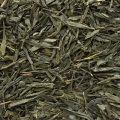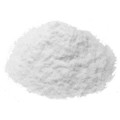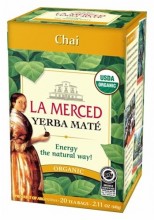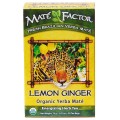 Loading... Please wait...
Loading... Please wait...- Home
- About Us
- Shipping, Returns & FAQ's
- Contact Us
-
For Your Information
- Canadian Customers Have a Choice if Shipping Via UPS
- Aura Cacia Homemade Aromatherapy Recipes
- Bella Nella Altered Art & Paper Crafts Blog
- Forms of Herbal Preparations
- Laundry Tips To Conserve Energy Blog from The Laundress
- The Story of Frontier Natural Products Co-Op
- Sovereign Silver Hydrosol and Aloe Protocol Stops Downward Spiral of Gut Dysbiosis
- Disclaimers
- Recommended Links
- RSS/Recent News
- The Story of Typhoon Housewares
- Reviews/Testimonials
- Raw Ingredients for Mfg
La Merced Yerba Mate Chai Certified Organic 20 Tea Bags CLOSEOUT SALE
Product Description
Best by dating 11/2011. All sales final.
Ingredients: 84.5% Organic Yerba Mate 5% Nat Chai Flavour 4% organic black pepper 4% Organic Cinammon 2.5 Organic ginger
Yerba mate was discovered centuries ago by the indigenous people in South America and has been revered as the “drink of the gods” and consumed to enhance, vitality, clarity, and well-being. With 24 vitamins and minerals, 15 amino acids, 11 polyphenols, caffeine, and is high in antioxidants, yerba mate triumphs as nature’s most balanced stimulant.
Of the six commonly used stimulants in the world--yerba mate, coffee, tea, kola nut, cocoa, and guarana--yerba mate is the healthiest, delivering both energy and nutrition.
• Helps Stimulate Focus and Clarity*
• Boosts Physical Energy*
• Traditionally Used to Support Weight Loss Programs that Include a Balanced Diet and Exercise*
• Aids Elimination*
• Contains Antioxidants*
Helps Stimulate Focus and Clarity
Yerba mate has the ability to quicken the mind and increase mental alertness and acuity. Yerba mate also provides sustainable energy due to its complex combination of xanthine alkaloids and caffeine. Although its caffeine content is comparable to coffee, the stimulation is balanced by yerba mate’s nutritional content. Clinical studies have shown that caffeine-sensitive individuals generally have very positive results and don’t experience the hard side effects (jitters, stomach discomfort, headache) commonly associated with caffeine.
Boosts Physical Energy
Yerba mate is a central nervous system stimulant. The metabolic effects of mate appear to include the ability to maintain aerobic breakdown of carbohydrates during exercise for long periods of time. As a result, more calories are burned, thereby increasing cardiac efficiency and delaying the build-up of lactic acid. Additionally, mate’s blend of xanthine alkaloids: caffeine, theophylline and theobromine, provide sustaining energy.
Traditionally Used to Support Weight Loss Programs that Include a Balanced Diet and Exercise.
For many years now, physicians in Europe have been incorporating yerba mate in treatments for obesity. In 2000, a research team studying obesity at the Charlottenlund Medical Center in Denmark tested an herbal preparation of Yerba Mate, Guarana, and Damiana (YGD) for gastric emptying and subsequent weight loss. They concluded that the herbal preparation, YGD capsules, significantly delayed gastric emptying, reduced the time to perceived gastric fullness and induced significant weight loss over 45 days in overweight patients treated in a primary health care context. In addition, maintenance treatment given in an uncontrolled context resulted in no further weight loss, nor weight regain in the group as a whole. Guayaki recommends that the product be used as part of a program that includes a healthy diet and sufficient exercise.
Aids Elimination
The indigenous of South America traditionally use yerba mate to treat gastrointestinal disorders as eupeptic and choleretic agent. Research conducted by a team at Catedra de Farmacologia in Buenos Aires, Argentina found that yerba mate does in fact induce an increase in bile flow and enhance intestinal transit.
Fights Bad Breath
Polyphenols found in tea and yerba mate have been shown to prevent both the growth of bacteria responsible for bad breath and the bacteria’s production of odorous compounds.
It is quickly becoming the beverage of choice for better health, energy and well being. Due to its growing popularity yerba mate is also being incorporated into bottled energy drinks, diet pills, and more.
The gauchos made Yerba Mate their constant companion. After a hard day's work on the pampas, they would gather around the campfire and pass the gourd around so that each could share the refreshing beverage.
Today it is the way millions in South America start the day, greet guests, and share good times with family and friends.
References
Bracesco N, Dell M, Rocha A, Behtash S, Menini T, Gugliucci A, Nunes E., “Antioxidant Activity of a Botanical Extract Preparation of Ilex paraguariensis: Prevention of DNA Double-Strand Breaks in Saccharomyces cerevisiae and Human Low-Density Lipoprotein Oxidation.”
J Altern Complement Med. 2003 Jun;9(3):379-87.
Actis-Goretta L, Mackenzie GG, Oteiza PI, Fraga CG. “Comparative study on the antioxidant capacity of wines and other plant-derived beverages.”
Ann N Y Acad Sci. 2002 May;957:279-83.
Gugliucci A, Menini T. “Three different pathways for human LDL oxidation are inhibited in vitro by water extracts of the medicinal herb Achyrocline satureoides.”
Life Sci. 2002 Jun 28;71(6):693-705.
Filip R, Lopez P, Giberti G, Coussio J, Ferraro G. “Phenolic compounds in seven South American Ilex species.”
Fitoterapia. 2001 Nov;72(7):774-8.
Andersen T, Fogh J. “Weight loss and delayed gastric emptying following a South American herbal preparation in overweight patients.”
J Hum Nutr Diet. 2001 Jun;14(3):243-50.
Gorzalczany S, Filip R, Alonso MR, Mino J, Ferraro GE, Acevedo C. “Choleretic effect and intestinal propulsion of 'mate' (Ilex paraguariensis) and its substitutes or adulterants.”
J Ethnopharmacol. 2001 May;75(2-3):291-4.
Athayde ML, Coelho GC, Schenkel EP. “Caffeine and theobromine in epicuticular wax of Ilex paraguariensis A. St.-Hil”
Phytochemistry. 2000 Dec;55(7):853-7.
Schinella GR, Troiani G, Davila V, de Buschiazzo PM, Tournier HA.
“Antioxidant effects of an aqueous extract of Ilex paraguariensis.”
Biochem Biophys Res Commun. 2000 Mar 16;269(2):357-60.
Martinet A, Hostettmann K, Schutz Y. “Thermogenic effects of commercially available plant preparations aimed at treating human obesity.”
Phytomedicine. 1999 Oct;6(4):231-8.
Vera Garcia R, Basualdo I, Peralta I, de Herebia M, Caballero S. “Minerals content of Paraguayan yerba mate (Ilex paraguariensis, S.H.).”
Arch Latinoam Nutr. 1997 Mar;47(1):77-80.
Gugliucci A. “Antioxidant effects of Ilex paraguariensis: induction of decreased oxidability of human LDL in vivo.”
Biochem Biophys Res Commun. 1996 Jul 16;224(2):338-44.
Kraemer KH, Taketa AT, Schenkel EP, Gosmann G, Guillaume D.
“Matesaponin 5, a highly polar saponin from Ilex paraguariensis.”
Phytochemistry. 1996 Jul;42(4):1119-22.
Schenkel EP, Montanha JA, Gosmann G.
“Triterpene saponins from mate, Ilex paraguariensis.”
Adv Exp Med Biol. 1996;405:47-56.
Gosmann G, Guillaume D, Taketa AT, Schenkel EP.
“Triterpenoid saponins from Ilex paraguariensis.”
J Nat Prod. 1995 Mar;58(3):438-41.
Gugliucci A, Stahl AJ. “Low density lipoprotein oxidation is inhibited by extracts of Ilex paraguariensis.”
Biochem Mol Biol Int. 1995 Jan;35(1):47-56.
Tenorio Sanz MD, Torija Isasa ME.
“Mineral elements in mate herb (Ilex paraguariensis St. H.)”
Arch Latinoam Nutr. 1991 Sep;41(3):441-54. Spanish.
MacMahon B, Yen S, Trichopoulos D, Warren K, Nardi G.
”Coffee and cancer of the pancreas.”
N Engl J Med. 1981 Mar 12;304(11):630-3.
Zhu M et al. Effect of Tea Polyphenols on Growth and H2S Production of Halitosis Causing Bacteria. University of Illinois at Chicago.
Presentation at the 2003 annual meeting of the American Society for Microbiology.
Alcohol, tobacco, diet, mate drinking, and esophageal cancer in Argentina. Castelletto R, Castellsague X, Munoz N, Iscovich J, Chopita N, Jmelnitsky A.
Departamento de Patologia, Facultad de Ciencias Medicas de la Plata, Argentina.
You Recently Viewed...
Currency Converter
Choose a currency below to display product prices in the selected currency.




























